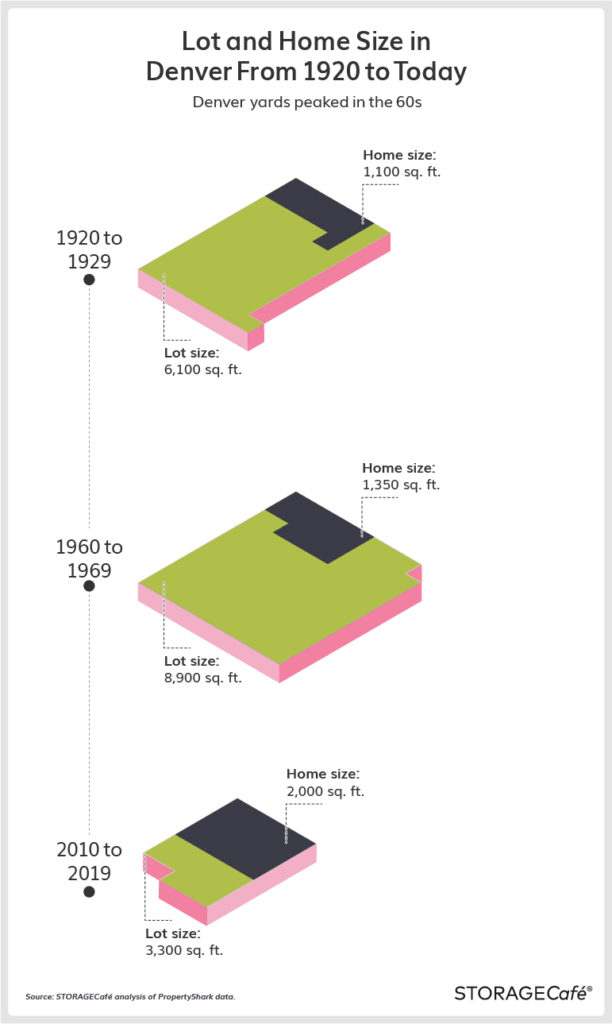By STORAGECafé
The median residential lot in Denver sits at around 6,200 square feet, while the median home size is around 1,300 sq. ft., according to recent research by StorageCafe. The report looked at the country’s top 20 cities and ranked them based on the median home lot size. Denver falls in the middle of the pack, with Indianapolis, Jacksonville and Austin taking the top positions for large yard spaces.
The research also looked at the evolution of lot size and home size over the past 100 years in the 20 cities analyzed. The main take is that lot usage (the percentage of a land plot occupied by the home) increased across the board, mainly due to a gradual expansion of median home size. Here’s how the median lot and home size changed in Denver over the past century:
Lot usage in Denver increased from 17% in the 1920s to 58% nowadays 
The median lot size in Denver in the 1920s was a little under 6,100 square feet. During the same decade, the median home size was around 1,100 sq. ft., which results in a 17% lot usage. However, lot usage increased significantly over time, reaching 58% for the past decade (2010 – 2019). Not only did the median lot size almost halve to an average of about 3,300 sq. ft. over that time, but homes grew, reaching a median size of 2,000 sq. ft. during the same period.
Naturally, this leads to less backyard space for newly built homes. This lot shrinkage is likely continue in Denver and beyond, due to an increased need for more housing in urban areas, combined with the buyers’ preferences toward bigger homes with growing construction costs. Maximizing lot usage is one way to reconcile all those factors.
Homes built in Denver in the 60s enjoy the biggest lots
The best decade for lot sizes in Denver was 1960 – 1969 – homes built in the 60s had median lots of almost 8,900 square feet. The median home size during the same decade stood at 1,350 square feet. Lot sizes are relatively large for homes built in the 1970s as well – around 8,200 square feet.
Homes built during the 90s hit a sweet spot for many potential homebuyers in both lot size and home size. Lots are around 6,000 sq. ft., while the median home size, at 1,800 sq. ft., is significantly larger compared to the previous decades, appealing to contemporary needs and preferences. The smallest homes were built in Denver during the 1940s – around 1,000 square feet, while the median lot size was around 6,300 square feet during the same decade.
Lot sizes vary significantly around the country, from 9,200 sq. ft. in Indianapolis to only 1,100 sq. ft. in Philadelphia
This trend is becoming visible all across the country. At a national level, home lots are decreasing, while new homes are getting bigger. The median lot size decreased by almost 18% over the past decade, from 10,500 sq. ft. in 2010 to 8,700 sq. ft. in 2020. The median size of a new home, however, was over 2,260 sq. ft. in 2020, up from 2,170 sq. ft. in 2010.
When looking at individual places, Indianapolis enjoys the largest lots among the country’s top 20 cities by population. The median lot size in Indianapolis stands at 9,200 square feet, while the median home size in the city is around 1,500 sq. ft.
Jacksonville, FL, with median lots of 9,100 sq. ft., and Austin, TX, with 8,600 sq. ft., rank second and third in this ranking.
Philadelphia has the smallest lots among the country’s biggest urban hubs – roughly 1,100 sq. ft. Residents of Chicago and Washington, DC, also have limited space around their homes, with median lot sizes of 1,700 sq. ft. and 2,600 sq. ft., respectively.
Philadelphia also has the smallest median home size, at 1,200 sq. ft., while the biggest median homes, of almost 2,100 sq. ft., can be found in Charlotte, NC. From this perspective, Denver, with a median home size of 1,300 sq. ft., ranks only 18th among the country’s top 20 cities.
Contact us for additional information!



